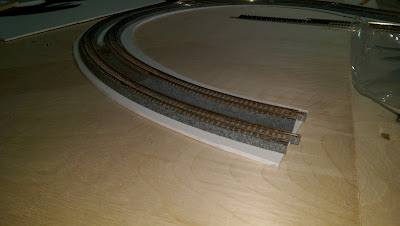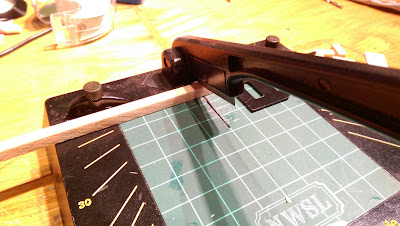Case in point is the "metro line". The metro will be an elevated line that I am imagining will snake through the city. As such, before any city planning can be done, the exact track layout for the two-track metro line needs to be determined (which is also constrained by the outer loops of the 'main line railways).
My original approach was to use Unitrack curves - the 216 and 249 radius curves -which would then connect to Atlas flex track for the non-curved sections. I decided not to use existing Kato viaduct sections as the walls are a bit too overwhelming and would block the trains. I wanted something a bit different, so I knew I would be scratch-building some sort of viaduct/elevated structure. So my original concept was to use 1/8" thick PVC foam board (one of my materials of choice!) as the base, and then mount the Unitrack to this material - with some sort of siding to make it look like an elevated trestle or viaduct system.
However, as I was browsing online various prototype photos of the U-bahn, Chicago El, NYC's elevated sections, I began to see the problem. The Unitrack ballast just won't look quite right and is not really a feature of elevated track. So..what to do? I also notice that a lot of elevated sections tend to be nothing more than girders, ties, and rails. Not a lot of 'flat space'.
So what I decided to do was abandon Unitrack and go with some classic snap track - in this case I'll be using Minitrix's R1 and R2 radii curves (which also means much tighter curves at 194.6 and 228.2 radii - which should be better for my cityscape than the wider curves. I am a bit concerned that these might be TOO tight, but as this is going to be a metro system, it's not like I'll be running any TGVs or traditional passenger cars on this line - well, at least that option is gone now!).
So I started with a new plan for my viaduct. After several different attempts using various easily available and cost efficient materials, I ended up with a plan that will use Evergreen Scale Models 1/4" thick plastic strips along with 1/4# wooden dowels available at the hardware store.
Across these structure sections will rest 0.80x0.80 square styrene strips that will support the actual track.
I'm using a 17mm spacing between the ends of the ties for each track, which will be identical to the doubletrack spacing of Unitrack sections, which seems like a useful benchmark.
Using my handy chopper (after a couple of years of gathering dust!) I'm back in business slicking strips of wood to make up the main structure!
And so, the initial straight section is complete! If this approach works out, then I'll proceed to creating the curves and the station section using the same basic format.







I like the look of your elevated track. It looks like it will be very rigid, but still have an open, airy, look to it. Nice.
ReplyDeleteWith 192.6 mm curves, you should be okay with most Japanese-manufactured single cars. Most of them seem to work okay even on 177mm curves. I did some testing a while back for one of my never-built tram lines that was going to have a commuter-style car. The real problem will be cars with body-mounted couplers. Those are probably going to need broader cars.
Do you know what you plan to run on the elevated line yet? Is it for a light-rail or subway-style line, or is it just an elevated normal rail line? The latter probably can't handle that kind of curve.
Hi Ken! Thanks for your comment! I plan on using Kato's Tokyo Metro series. I already have the 10-864 Ginza Line set, and may add another similar set for the other line. My idea is to have both tracks be automated, with each having a train running in seperate directions, but both will have automatic stops at the station. As soon as I get my Minitrix R1 and R2 track I'm going to test to ensure that these trains can handle these curves with no problem, but given how short these cars are and the generous range of their coupler motion, I don't anticipate an issue - thanks for your comment which confirms that this will probably be okay for a radii for these trains!
DeleteHi Jerry, I check on your blog now and then. Ross and I are glad we got to see your Quinntopia layout while it was still around (for Trackside Model Railroading). It is nice to see that you are getting started on a new layout now. I am guessing it will be urban like the last one? (You still have all those structures.) It will be interesting to see what you do differently this time. Happy New Year! Jenny Waters
ReplyDeleteI have Minitrix R1 track and a Piko Talent 2 runs fine over it. It doesn't look perfect, but the train runs fine.
ReplyDeleteThanks! That's good to know! I know that I'm going to have issues with some trains - that's what you get with R1! Good to know the Talent works though!
DeleteHi Jerry
ReplyDeleteDo you know tre Peco brand? they make some very fine products. Peco have a line of code 55 n-scale track in both concrete and woodden sleeper versions.
I have some experience with the version with wood sleepers, and they can be joined with other brands and codes of n-scale track. I have had succes with both Kato and Minitrix.
check out the links for further reference.
http://www.peco-uk.com/product.asp?strParents=3309,3310&CAT_ID=3315&P_ID=17117
https://www.google.dk/search?q=Code+55,+Concrete+Sleeper&espv=2&biw=1745&bih=868&source=lnms&tbm=isch&sa=X&ved=0ahUKEwj77pbF5dHKAhWEjiwKHUI6CkcQ_AUIBigB&dpr=1.1#imgrc=_
Kind regards, Claus
Hi Claus! Thanks for your message! Yes, I am familiar with Peco's Code 55-ish track and I do plan to use it on the main track lines. I debated using it on the Metro as well, but since I'm going to have super tight radii for the Metro, standard snap track and easily available code 80 will do for that line.
DeleteI agree though; I've admired layouts that used the Peco, even though it does not seem like a rail size could make that much difference, it really does have a much more realistic look!
However, like yourself, I was also thinking of combining it with kato switches and some of their super-elevated curves, so it will be something of a hybrid, and that you provide additional confirmation it will work together is encouraging!